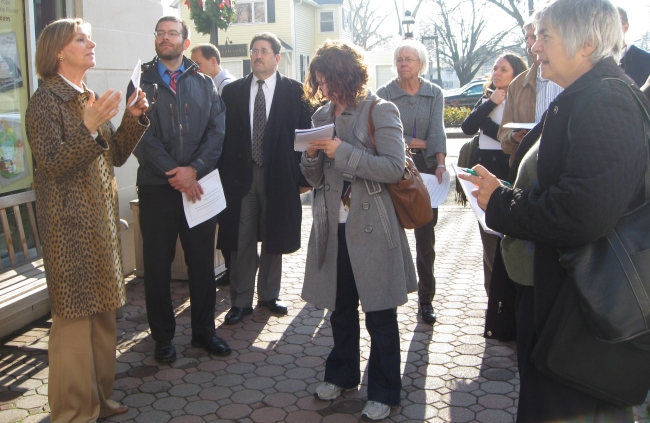
Interest in transit-oriented development (TOD) within Connecticut has rarely been higher. After releasing TOD grants to several cities and towns last year, the state has also moved forward on a TOD project in Stamford. A summer forum on TOD organized by the Partnership for Strong Communities drew a packed house and featured leaders from several state agencies.
Building on this momentum, TSTC and advocates brought state and local officials from Connecticut to see examples of successfully implemented TOD in northern New Jersey last week. The tour was organized by the TSTC and NJ Transit, with the generous support of the One Region Funders’ Group. The event was co-sponsored by the Connecticut Fund for the Environment, Partnership for Strong Communities and Regional Plan Association.
Getting things done
Attendees met with local officials in three very different municipalities: Cranford (population 22,625; median income $107,052 according to Census data), Rahway (population 27,346; median household income $58,551), and New Brunswick (population 55,181; median household income $44,543). What all three had in common was frequent rail service, a track record of successful TOD, and a state designation as a Transit Village, which allows municipalities to receive technical assistance and priority for state funding and financing.
To calm fears that new projects would put pressure on the school system, Cranford’s Downtown Management Corporation (DMC) used township education data to show that there were few school-age children in existing downtown apartments. This proved to be the case in new developments as well. “We initially had one high-school senior,” DMC Director Kathleen Prunty said of Cranford Crossing, a 50-unit mixed-use development in downtown Cranford. “Now we have none.”
In Cranford, most interest has come from “empty nesters” seeking smaller homes in a walkable neighborhood with shops and restaurants. “We were really surprised at how overwhelming the interest was,” Prunty said, noting that there are waiting lists for upcoming residential projects downtown.
In Rahway, former mayor Jim Kennedy explained how the small city had identified a niche. As local businesses struggled through the ’80s and early ’90s, city leaders recognized they were strategically located to become a regional arts hub, and built on assets like a run-down but historic vaudeville theater, which became the Union County Performing Arts Center. “We put all our eggs in the arts basket,” Kennedy said. Today, the city attracts national names to the performing arts center and theaters like Hamilton Stage, while also maintaining a smaller, community-driven arts scene.
But the strategy was viable only because of strong transit service. “It works because we have the transportation component, which excites the housing component, which drives demand for amenities,” Kennedy said. Over a thousand residential units have been added in the downtown area over the past 20 years.
Institutions have played a pivotal role in New Brunswick, city planner Glenn Patterson said. Robert Wood Johnson University Hospital, for example, has been a key partner in the Wellness Plaza, a mixed-use development that includes a supermarket and fitness center. And Rutgers University has helped anchor developments by leasing portions as student housing. It also provided a retail tenant–a new university bookstore–for the Gateway Transit Village mixed-use project.
The state role
At Rutgers’ Bloustein School of Public Policy, NJ Transit’s Vivian Baker explained that the Transit Village program is backed by a task force with representatives of eleven different state agencies. This reduces agency “turf wars” and means the task force can help municipalities navigate a wide range of state programs–from NJDOT’s Local Aid program to NJ Housing and Mortgage Finance Agency’s financing programs for affordable housing. “We wouldn’t be anywhere” without buy-in from multiple agency commissioners, Baker said.
The state doesn’t force TOD on municipalities, she said, but works to maintain the integrity of the Transit Village “brand” by requiring that localities meet firm criteria and demonstrate a willingness to develop around transit before they are designated. New Jersey’s program was created through administrative action and has remained popular through the tenure of multiple governors.

[…] Connecticut Studies Jersey’s Transit-Oriented Development Strategies (Mobilizing the Region) […]
[…] on the Network today: Ride Solutions takes a look at one of the collateral costs of road building. Mobilizing the Region reports that the state of Connecticut is eager to learn from New Jersey’s example in […]
[…] Interest in transit-oriented development (TOD) continues to grow in Connecticut as municipalities in the state plan to take full advantage of new transit lines like the CTfastrak bus rapid transit system and New Haven-Hartford-Springfield Rail Line. On June 4, local and state officials from Connecticut traveled north to Massachusetts to look at TOD in various settings, and learn about how it was implemented there. The trip was the second of two tours sponsored by Tri-State Transportation Campaign, the Partnership for Strong Communities, Regional Plan Association, and Connecticut Fund for the Environment with the support of the One Region Funders Group. The first took place in December 2012 in New Jersey. […]
[…] for the creation of a Transit Village Planning and Capital program, similar to New Jersey’s successful program, that helps municipalities plan and build […]
[…] then, Cranford has been focused on improving pedestrian access to transit and is considered a regional example for smart transit-oriented […]
[…] the lead of New Jersey and Connecticut, which both appear to be embracing transit-oriented development (TOD), as well as some communities in the Hudson Valley. This may seem strange for people who are […]
[…] part of the solution is to guide development in a way that takes advantage of transit. New Jersey has been doing this for years, but transit-oriented development is still a relatively new concept […]